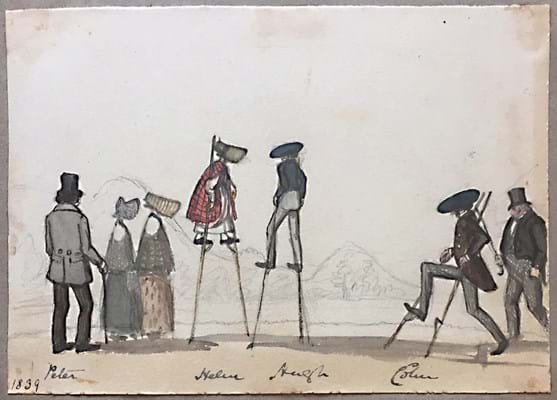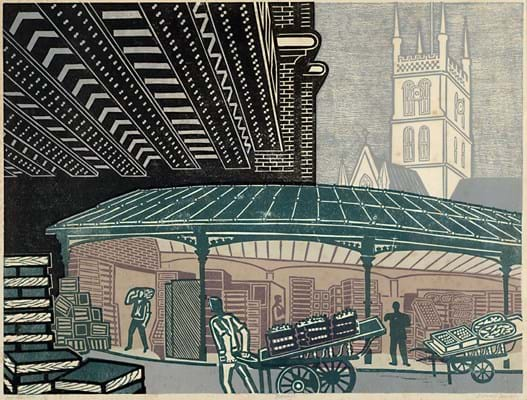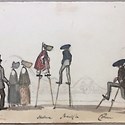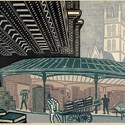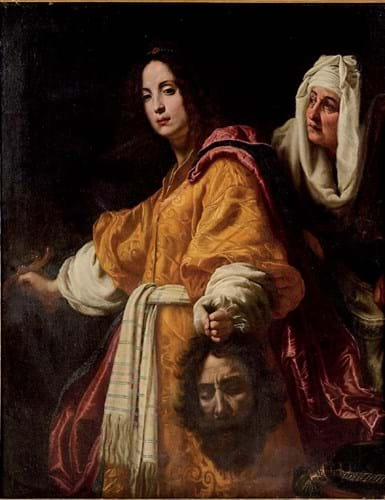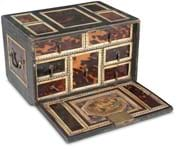“We see so many sketchbooks come in by artists of absolutely no consequence at all.” Fortunately, for Richard Kay of Somerset saleroom Lawrences (22% buyer’s premium), this was not the case for a small, incomplete sketchbook consigned by descendants of the 19th century Scottish artist and illustrator Jemima Blackburn (1823-1909).
“She was a distinctive personality in her own right, a homespun talent who enjoyed sketching and drawing and did it with her tongue in her cheek,” said Kay.
Offered in Crewkerne on July 6, the sketchbook went beyond hopes of £3000-4000 to sell for £10,100 to a Scottish collector with a “genealogical link” to the Blackburn family, added Kay.
Principally executed in watercolours between c.1838-60, the album contains some 80 illustrations by Blackburn of whimsical figures, animal subjects, figure groups and scenes of the Scottish Victorian middle classes at leisure, sport and recreation.
That the sketchbook was not entirely intact also did not seem to damage it commercially. “It is open season to take them apart if there is no complete coherent quality worth preserving,” said Kay.
Carlisles and Castle Howard
The sale also included a selection of 50 sketchbooks from the family of the Earls of Carlisle, containing a myriad of studies, many of them continental European views by minor members of the family spanning much of the 19th century and mostly unsigned.
The lion’s share of the interest focused on a small group of four views of Castle Howard in North Yorkshire – the most famous link to the Carlisle branch of the Howard family.
Estimated together at a cautious £500-700, reflecting the varied quality on offer, the group soared to £5000 where it was knocked down to the London trade against keen interest from two private bidders.
“The condition was good, the provenance was good and the sense of it being a collection from a family archive gave it unquantifiable extra appeal,” said Kay.
Bawden view of Borough Market
Top price in the print section was paid for an Edward Bawden (1903-89) lithograph of Borough Market, 1967, from his famous Six London Markets series published by Curwen Prints.
It had been bought by the owners from the Royal Academy in 1968 and came with a receipt for 15 guineas and a signed piece of notepaper from Bawden.
Almost exactly 50 years later to the day, the print sold to a London collector at £4200 – an auction record for the subject, according to the Art Sales Index.
Incidentally, Dulwich Picture Gallery’s exhibition until September 9, simply titled Edward Bawden, includes a substantial amount of prints and watercolours loaned from private collections – many which have never been exhibited publicly before.
Pick of the oils
The pick among the oils at Lawrences was a 17th century copy catalogued as after Cristofano Allori (1577-1621) of Judith with the head of Holofernes. Based on the prime version of c.1613- 20, it made nearly double its top guide at £13,000.
The well-preserved 4ft 3in x 3ft 4in (1.31 x 1.03m) oil on canvas had been in the same collection since 1980 and had once hung at Knowle, a grand country house in East Sussex.
“Although gruesome, Judith with the head of Holofernes has always been a popular image, partly because it shows a strong, capable, focused and determined woman,” Kay said. “Crucially, this example was a period copy.”
Later copies of Allori’s Judith tend to sell for significantly less: a smaller example dated after the 17th century sold in the same rooms in July 2016 for £1950.


